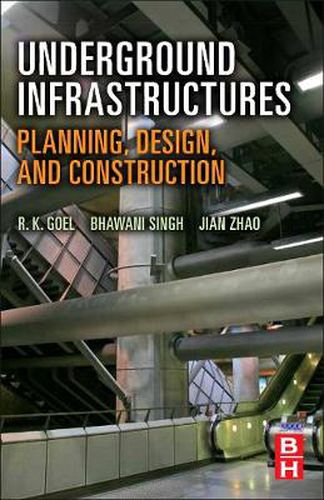Readings Newsletter
Become a Readings Member to make your shopping experience even easier.
Sign in or sign up for free!
You’re not far away from qualifying for FREE standard shipping within Australia
You’ve qualified for FREE standard shipping within Australia
The cart is loading…






Underground facilities, such as tunnels, sewer, water and gas networks form the backbone of the economic life of the modern city. In densely populated areas where the demands for transportation and services are rapidly increasing and the construction of new roads and railways are prohibited, the construction of a tunnel might be the only alternative. Brief and readable, this reference is based on a combined 75 years of field experience and places emphasis is on simple practical rules for designing and planning, underground infrastructures. The books’ begins with a clear and rigorous exposition of the classification of underground space, important considerations such as geological and engineering and underground planning. This is followed by self-contained chapters concerning applications for underground water storage, underground car parks, underground metros & road tunnels and underground storage of crude oil, lpg and natural gas. The book has 15 chapters covering various usage of underground space. There are about 135 figures and tables. The book contains about 20 case histories/examples.
One of the first book to address all of the major areas in which this technology is used, this book deals with major topics such as: hydroelectric projects with modern planning of complex underground structures; underground storages of food items, crude oil and explosives and highly cautious underground nuclear waste repositories. Rail and road tunnels and TBM are described briefly. Risk management in underground infrastructures is of vital importance. Civil Engineers, Mining Engineers, and Geotechnical Engineers will find this book a valuable guide to designing and planning underground infrastructures both in terms of its applications.
$9.00 standard shipping within Australia
FREE standard shipping within Australia for orders over $100.00
Express & International shipping calculated at checkout
Underground facilities, such as tunnels, sewer, water and gas networks form the backbone of the economic life of the modern city. In densely populated areas where the demands for transportation and services are rapidly increasing and the construction of new roads and railways are prohibited, the construction of a tunnel might be the only alternative. Brief and readable, this reference is based on a combined 75 years of field experience and places emphasis is on simple practical rules for designing and planning, underground infrastructures. The books’ begins with a clear and rigorous exposition of the classification of underground space, important considerations such as geological and engineering and underground planning. This is followed by self-contained chapters concerning applications for underground water storage, underground car parks, underground metros & road tunnels and underground storage of crude oil, lpg and natural gas. The book has 15 chapters covering various usage of underground space. There are about 135 figures and tables. The book contains about 20 case histories/examples.
One of the first book to address all of the major areas in which this technology is used, this book deals with major topics such as: hydroelectric projects with modern planning of complex underground structures; underground storages of food items, crude oil and explosives and highly cautious underground nuclear waste repositories. Rail and road tunnels and TBM are described briefly. Risk management in underground infrastructures is of vital importance. Civil Engineers, Mining Engineers, and Geotechnical Engineers will find this book a valuable guide to designing and planning underground infrastructures both in terms of its applications.